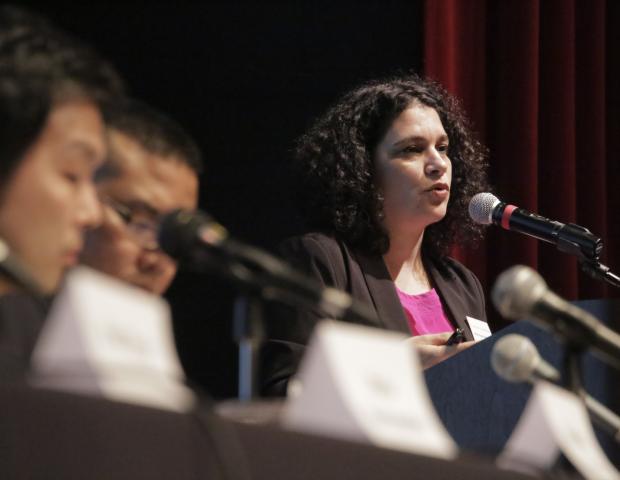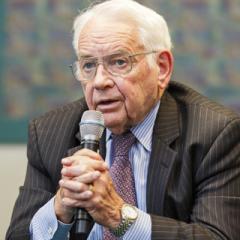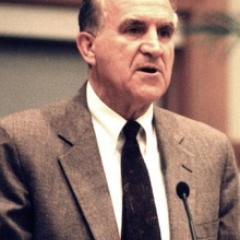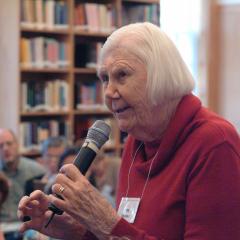Peace Education Around the Globe at USF
Panelist Maria Hantzopoulos of Vassar College
We can aspire for a world defined by domination and conquest, superiority and oppression, or we can aspire for a world defined by dignity and respect, collaboration, and solidarity. Educating for the latter, said Kevin Kumashiro, is a core purpose of School of Education at the University of San Francisco (USF), where he is dean. It also was the subject of “Glimmers of Hope: Peace Education Around the Globe,” a panel discussion co-sponsored on March 11, 2016 by USF* and the Ikeda Center. More than two hundred Bay Area students, educators, and community members attended the event, which is reported on here by the Center’s Mitch Bogen.
In his introductory remarks, moderator Mahi Takazawa confirmed Dean Kumashiro’s claim. A native of the war-torn Sri Lanka of the late 20th century, Takazawa said that pervasive “ethnocentric educational policy” there contributed substantially to the civil war that for decades terrorized civilians of all ethnicities, resulting in the loss of more than 100,000 lives. “All for nothing,” he said. Now a doctoral student at USF, Takazawa is researching how we can build peace through global citizenship education and Soka (value-creating) education, a still-urgent mission, he noted, as the Syrian war and refugee crisis, among many other human rights crises, demonstrates. He is also a former Ikeda Center Education Fellow.
Takazawa then introduced the panelists: Monisha Bajaj, Associate Professor of International and Multicultural Education at the USF School of Education, and co-developer of the event with the Ikeda Center; Maria Hantzopoulos, Associate Professor of Education at Vassar College; Tetsushi Ogata, Lecturer in Peace and Conflict Studies at the University of California, Berkeley; and Matt Meyer, a New York City-based educator, activist, and author, and among other positions, the coordinator of the War Resisters International Africa Support Network. Bajaj and Hantzopoulos are co-editors of the new book Peace Education: International Perspectives, and the event served as an informal launch and celebration of the volume.
Prior to convening the full panel for a dialogue with attendees, each panelist gave a brief presentation placing their work in the context of peace education. A few themes cut across their remarks. First of all, was the debt these scholars owed to the work of Johan Galtung, known as the “father of peace studies.” Another foundational reference was to Daisaku Ikeda’s outline of the three essential attributes of global citizenship, from his 1996 lecture at Teachers College, Columbia University: 1) the wisdom to perceive the interconnectedness of all life and living; 2) the courage not to fear or deny difference; but to respect and strive to understand people of different cultures, and to grow from encounters with them; and 3) the compassion to maintain an imaginative empathy that reaches beyond one’s immediate surroundings and extends to those suffering in distant places. Thirdly, and most centrally, they advocated versions of “critical peace education,” with an emphasis on helping students situate themselves within their schools and communities and to develop the awareness, confidence, and ability to alter their personal and social circumstances toward peaceful and creative coexistence, wholeness, and justice.
Peace Education: Challenges and Transformations
First to speak, Tetsushi Ogata said by way of definition that conflict results from people pursuing incompatible goals, or from the existence of a perceived incompatibility of interests and aspirations. He clarified, however, that the field of conflict resolution studies has been, unfortunately, better at defining what conflict is and analyzing why and how it occurs — at deconstructing it — than exploring what peace actually looks like, what it entails in practice. In Ogata’s view, the field has suffered by its reductionist orientation that is too prevalent in social sciences and being disconnected from peace education that aims at fostering human characters for peace. The goal must be not only to analyze conflict, but also to pursue “positive peace” — which Galtung said is 1) characterized by cooperation among conflict parties for “mutual and equal benefits” and 2) recognized by a shared attitude “to suffer the suffering of others, and to enjoy the joy of others.” This latter condition relates closely to the third of Daisaku Ikeda’s global citizenship factors: employing imaginative empathy to understand the suffering of distant others. This human quality is precisely what lacks in the pedagogy of conflict resolution studies.
There are tools such as the Global Peace Index (issued by the Institute for Economics and Peace), said Ogata, measuring the qualities of peace in nations around the world, even attempting to measure the level of positive peace, though the qualities of true positive peace, as proposed by Galtung and Ikeda, are not so easily captured by these existing measures, said Ogata. In his view, the conflict resolution field could learn from the peace education field, by further exploring personal, ethical, and philosophical dimensions — the more subjective dimensions — of peace.
Monisha Bajaj, who directs USF’s graduate program in Human Rights Education (the nation’s first), introduced her work studying and contributing to peace and human rights education among marginalized populations in the Global South, as well as the Global North. To open, Bajaj said that in Peace Education: International Perspectives as well as in her own courses, peace education is understood as that which is aimed at:
- The transforming of content, structure and pedagogy of education to address direct, structural, and cultural forms of violence (especially as conceptualized by Galtung)
- The creation of new ways of learning rooted in a comprehensive and holistic notion of peace.
Turning to her work in India, which she covers in her own chapter in Peace Education, Bajaj said that peace education initiatives there are quite diverse, but can be categorized into three distinct but overlapping domains or levels. The first domain is largely personal, functioning as a form of values or character education. The next frames peace education as a response to inter-group violence. The third level functions as a critique of structural violence. Dr. Bajaj drew special attention to the second level, where groups in India are expanding beyond the search for commonality and are now thinking carefully about pluralism, i.e., how people and groups can live together creatively while respecting their differences. She closed with a quote from Anupama Srinivasan on how Gandhi was much more than a righteous individual. Rather, he “was one of the first to integrate ideas of social justice with a ‘state of peace,’ by recognizing the potential dangers of poverty, inequality & discrimination.”
Dr. Hantzopoulos discussed findings from her research observing the practice of critical peace education at Humanities Preparatory Academy, a NYC public high school and the subject of her chapter in Peace Education. The backdrop to her remarks was the neoliberal school reform movement that prioritizes high-stakes standardized testing and privatized management structures, causing increases in suspensions and dropouts and the overall dehumanization of the school environment. In contrast to the test-based reform movement, said Hantzopoulos, critical peace education is 1) context-specific, with awareness of localized structural inequities; 2) transformative and supportive of student agency, especially in localized contexts; and 3) multi-pronged and non-linear. To illustrate the power of critical peace education, she shared reflections from former Prep Academy students that she interviewed during her research. One girl recalled what she learned from joining with other students to go to City Hall to protest high-stakes testing:
You hear about people doing these amazing things, these protests and these campaigns … you never realize that those people are the same people as you. There’s nothing about them that’s extraordinary, except that they choose to be extraordinary people.
She also quoted students who developed a new comfort with and commitment to education because of Prep’s non-hierarchical atmosphere — where “teachers, students, and everyone interacted with each other and looked at one another as equals,” creating “a true sense of democracy.” To conclude, Prof. Hantzopoulos said that peace education at Humanities Prep is not merely a matter of curriculum; it is realized in the structure and culture of the school itself.
How do we maintain hope when hopelessness seems omnipresent? That was the core theme of Matt Meyer’s talk. Meyer is both an activist and an educator, with his original motivation flowing from the former. As his career in anti-war and anti-nuclear activism progressed he kept noting that many of his mentors in politics were also teachers. So when he found himself right out of college with an opportunity to teach, he realized that there could be a fertile cross connection between peace activism and peace education, that an effective “pedagogical practice and approach” can apply “equally to students and one’s fellow human beings.”
Meyer places “a passion for people” at the heart of both his teaching and activism. Along with this passion, Meyer’s early years in education — when he worked with students who were often “one step from incarceration” — were powered by a strong sense of “possibility and hope.” Now, with more than thirty years of activism and teaching under his belt, Meyer admitted that he is feeling less hopeful than he has in many years. The reasons are clear, including the heavy incarceration rates in the US, especially among young men of color, and the influential wave of “corporate” school reform that is “turning teachers into cogs in machines,” and stripping schools of a sense of “community and love.” But still, he said — but still there are “glimmers of hope”:
- In the ethic of Ubuntu, the notion that “your life and my life are wrapped up in one another,” which the South African freedom movement bequeathed to the world;
- In Ferguson, where the community is engaged in a truth-telling process, the necessary first step toward empowerment and justice;
- In Mozambique, where steps are being taken to end the militarization of youth;
- And in the legacy of Vincent Harding and all the elders of the US freedom struggle who taught us, “America will be, on it’s best days, all that it wishes to be.”
Meyer concluded by addressing the group, saying that all we need to do to know that hope makes sense is to take a good look at one another.
Unity, Disruption, Hope
Moderator Mahi Takazawa solicited questions and comments from attendees in two sets, thus giving panelists the ability to respond based on their particular interests as well as to weave themes and ideas together.
I. Justice and the Problem of Labeling
Isn’t justice the most essential aspect of any peace movement? In response to this question Dr. Bajaj agreed that certainly it is central. In both peace and human rights education, she said, the quest for justice is connected to the struggle both to keep expanding our notion of who is fully human and to assert the equal humanity of every individual on the planet. This point related closely to the remarks of two of a group high school students in attendance whose presence energized the proceedings. These students felt that there was a real disconnect at their school between the way students perceived each other — without labels — and the way some faculty tried to peg and pigeonhole students of color into stereotypical identities, often to the detriment of their academic development. Can’t we get past all the harmful labeling, they wondered? Dr. Bajaj responded by saying that some labels, as with Black Lives Matter, are intended as a proactive response to historic and systemic dehumanization. So the label serves an educational and ethical purpose. Dr. Hantzopoulos agreed, and also expressed concern about such ill-advised and inadequate teaching from certain faculty. The sad truth, she said, is that there are teachers out there who aren’t prepared to participate in our public schools in productive ways. On the other hand, she stressed, there are many great teachers who care deeply about injustice and doing right by their students.
“You get to determine your own label.”Regarding justice, Matt Meyer said that it is indeed central to peace education and peace activism, and things have progressed over the last couple decades to the point that educators and activists rarely consider them in isolation. Crucial to both is a commitment to truth telling, as we see today in Ferguson, Meyer said. We simply can’t move forward if we pretend that certain injustices don’t exist. As much as we want to “increase the peace,” he added, sometimes we also want to “increase the confrontation.” As for labeling, Meyer stressed that labels do have a place, with the key distinction being “that you get to determine your own label,” a point made beautifully, he said, by Paula Giddings in her book When and Where I Enter. Nevertheless, labels present a double-edged sword, said Meyer: For every instance of prejudicial language limiting someone, there is another instance of self-chosen labeling helping someone to realize their potential, individually and socially. Dr. Hantzopoulos added the distinction that beneath the matter of labeling is the challenge and imperative of treating everyone with respect and dignity, especially when it comes to teacher’s treatment of students.
In response to a question about the problem of applying conflict resolution processes in Syria, Dr. Ogata said that there is “no short answer” for this kind of conflict, which is multi-layered with multiple shifting and conflicting alliances. We must take a long-range perspective, Ogata said, and envision processes in which concerns for human rights begin to supersede the sovereignty of states. Some examples are taking shape, such as veto reform initiatives at the United Nations Security Council and ongoing debates on how to implement and streamline the international doctrine of the responsibility to protect. They are certainly not enough to resolve the Syrian conflict today, but we must also acknowledge that there are signs of people and states making progress – slow but real – in the protection of human lives. Through our determined efforts, humanistic ethical values can increasingly shape global structures and systems, he said.
II. Truth, Reconciliation, and Taking a Stand
Picking up on Meyer’s remarks, the first attendee to speak in the next sequence emphasized the absolute necessity of truth and reconciliation processes — not just overseas, but here in the United States where a full reckoning with the reality and legacy of slavery has yet to occur on a broad level. In her view, part of that legacy is in the news today, as our first black president is being blocked from carrying out his constitutional responsibility to name a new Supreme Court justice. The next comment was from a teacher trainer-coach who added that from the Nichiren Buddhist perspective seeking to deny or escape reality is a grievous error and obstacle to justice, as is seeing reality clearly but just passively accepting it. Her opinion is that school systems tend to encourage these errors.
First to respond, Dr. Ogata emphasized that when we talk about paired concepts such as peace and justice or truth and reconciliation we tend to dichotomize them or prioritize one over the other. Some prefer peace to justice, or they might accept truth telling without taking the necessary next steps. In reality, Ogata said, these are complementary components of the same struggle for a more humanistic and flourishing world. They “reinforce each other,” he said. Hantzopoulos concurred, saying that truth and reconciliation don’t exist in a linear relationship, with one neatly following the other.
Truth telling also includes instances of triumph in pursuit of justice.Truth telling is a core part of peace education as well as a mode of activism. In response to a question on effective curriculum strategies for peace education, Dr. Bajaj clarified that facing reality doesn’t only mean cataloguing injustices but also instances of triumph in pursuit of justice. She recently attended a presentation on new courses being developed on the Africa diaspora of the last several centuries. Bajaj said that the focus is less on slavery itself than on stories of successful resistance — which can be expressed through art, music, politics, and more. It is vital in peace education, she said, to avoid orientations that can unintentionally amount to “re-victimization.”
Something that more and more students, teachers, and parents are speaking out about is the tyranny of the high-stakes testing regimen and its deleterious impact on learning. The last person to speak shared how he joined the testing “opt-out” movement at his school, but worried about the negative impacts that decision might have had the school, including on funding or other factors tied to test performance. Bajaj said that this kind of civil disobedience is a vital form of “disruption” that can help to delegitimize an unwise or unjust policy. But civil disobedience usually comes with some kind of price, she said. Hantzopoulos remarked that actions such as his are vital to changing our educational culture for the better. She is especially hopeful about this after seeing how the opt-out movement in New York State recently forced the governor to relent on his proposed policy to tie teacher evaluations to standardized test scores.
Matt Meyer emphasized that all of us working for peace and justice need to become increasingly creative in order to achieve the changes that are needed, especially in these waning days of the “American empire.” We need new coalitions, he said, including coalitions that will “move the pendulum” toward peace and the creation of King’s “beloved community.” And we need to break through mythologies, including the mythology that seduces us into believing that the success of transformative social movements results from the leadership of “great saints,” and not because of the hard work of everyday people – echoing here the remarks of the young woman from Humanities Prep. And finally, Meyer reminded everyone that enormous change only ever happens “at the last moment.” ** In other words, positive and just social change seems like it will never happen — until it does, as was the case in South Africa. Then, said Meyer, “we realize it was inevitable all along.”
Notes
* USF co-sponsors included the School of Education, the International and Multicultural Education Department, the Human Rights Education Program, and the Peace and Justice Studies Minor.
** Here Mr. Meyer is referencing an observation made by the American writer and activist Grace Paley.



